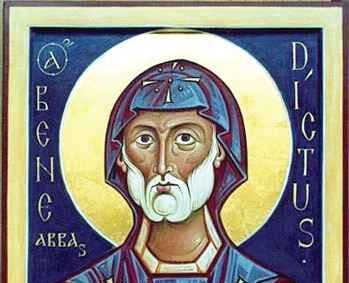Contenus
ToggleIn short
Benoît de Nursie OSB (latin : Benedictus Nursiae ; italien : Benedetto da Norcia ; 2 mars 480 AD – 21 mars 548 AD) était un moine chrétien italien, écrivain et théologien qui est vénéré dans l’Église catholique, l’Église orthodoxe orientale, le Églises orthodoxes orientales, Communion anglicane et Églises vieilles-catholiques. Il est un saint patron de l’Europe.

Benoît de Nursie, saint patron de l'Europe
Il était le fils d’un noble romain de Nursie, la Norcia moderne, en Ombrie. Une tradition que Bede accepte fait de lui un jumeau avec sa sœur Scholastique. Si 480 est accepté comme année de sa naissance, l’année de son abandon de ses études et de son départ de la maison serait d’environ 500. Le récit de Gregory rend impossible de supposer qu’il avait moins de 20 ans à l’époque.
Benoît a été envoyé à Rome pour étudier, mais a été déçu par la vie qu’il y a trouvée. Il ne semble pas avoir quitté Rome dans le but de devenir ermite, mais seulement pour trouver un endroit à l’écart de la vie de la grande ville. Il emmena avec lui sa vieille nourrice comme servante et ils s’installèrent à Enfide. Enfide, que la tradition de Subiaco identifie avec l’Affile moderne, se trouve dans les montagnes Simbruini, à environ quarante milles de Rome et à deux milles de Subiaco.
A peu de distance d’Enfide se trouve l’entrée d’une vallée étroite et sombre, pénétrant dans les montagnes et menant directement à Subiaco. Le chemin continue à monter, et le côté du ravin, sur lequel il court, devient plus escarpé, jusqu’à ce qu’une grotte soit atteinte au-dessus de laquelle la montagne s’élève maintenant presque perpendiculairement; tandis qu’à droite, il s’abat en une descente rapide jusqu’à l’endroit où, au temps de Benoît, 150 m plus bas, gisaient les eaux bleues d’un lac. La grotte a une grande ouverture de forme triangulaire et mesure environ dix pieds de profondeur.
En revenant d’Enfide, Benoît rencontra un moine, Romanus de Subiaco, dont le monastère se trouvait sur la montagne au-dessus de la falaise surplombant la grotte. Romanus avait discuté avec Benoît le but qui l’avait amené à Subiaco, et lui avait donné l’habit du moine. Sur ses conseils, Benoît devint ermite et vécut pendant trois ans, à l’insu des hommes, dans cette grotte au-dessus du lac.
Gregory nous en dit peu sur ces années. Il parle désormais de Benoît non plus comme d’un jeune (puer), mais comme d’un homme (vir) de Dieu. Romanus, nous dit Gregory, a servi Benoît de toutes les manières possibles. Le moine lui rendait apparemment visite fréquemment et, à des jours fixes, lui apportait de la nourriture.
Au cours de ces trois années de solitude, interrompues seulement par des communications occasionnelles avec le monde extérieur et par les visites de Romanus, Benoît a mûri à la fois dans l’esprit et dans le caractère, dans la connaissance de lui-même et de son prochain, et en même temps il est devenu non simplement connu, mais assuré le respect de ceux qui l’entourent; à tel point qu’à la mort de l’abbé d’un monastère du voisinage (identifié par certains à Vicovaro), la communauté vint à lui et le pria d’en devenir l’abbé.
Benoît était au courant de la vie et de la discipline du monastère, et savait que « leurs manières étaient différentes des siennes et donc qu’ils ne s’accorderaient jamais ensemble: pourtant, enfin, vaincu par leurs supplications, il donna son consentement » (ibid., 3).
L’expérience a échoué; les moines ont essayé de l’empoisonner. La legend raconte qu’ils ont d’abord essayé d’empoisonner sa boisson. Il a prié une bénédiction sur la coupe et la coupe s’est brisée. Ainsi, il quitta le groupe et retourna dans sa grotte de Subiaco. Il habitait dans le voisinage un prêtre appelé Florentius qui, poussé par l’envie, essaya de le perdre. Il a essayé de l’empoisonner avec du pain empoisonné. Quand il a prié une bénédiction sur le pain, un corbeau est entré et a emporté le pain.
A partir de ce moment, ses miracles semblent être devenus fréquents, et de nombreuses personnes, attirées par sa sainteté et son caractère, sont venues à Subiaco pour être sous sa direction. Ayant échoué en lui envoyant du pain empoisonné, Florentius tenta de séduire ses moines avec quelques prostituées. Pour éviter de nouvelles tentations, vers 530, Benoît quitta Subiaco. Il a fondé 12 monastères dans les environs de Subiaco et, finalement, en 530, il a fondé le grand monastère bénédictin de Monte Cassino, qui se trouve sur une colline entre Rome et Naples.
Lors de l’invasion de l’Italie, Totila, roi des Goths, ordonna à un général de porter ses robes royales et de voir si Benoît découvrirait la vérité. Benoît a immédiatement détecté l’usurpation d’identité et Totila est venu lui rendre hommage.
Benoît a écrit la Règle en 516 pour les moines vivant en communauté sous l’autorité d’un abbé. La Règle comprend soixante-treize courts chapitres. Sa sagesse est double : spirituelle (comment vivre une vie christocentrique sur terre) et administrative (comment gérer efficacement un monastère). Plus de la moitié des chapitres décrivent comment être obéissant et humble, et que faire lorsqu’un membre de la communauté ne l’est pas. Environ un quart réglemente l’œuvre de Dieu (« opus Dei »). Un dixième décrit comment et par qui le monastère doit être géré.
Social networks
Today, Christians commemorate Benedict of Nursia, Saint Benedict. He is considered by Catholics and Orthodox as the patriarch of Western monks, thanks to his rule which had a major impact on Western monasticism and even medieval European civilization. #mythology #myth #legend #calendar #11July #saintbenoit
Picture
